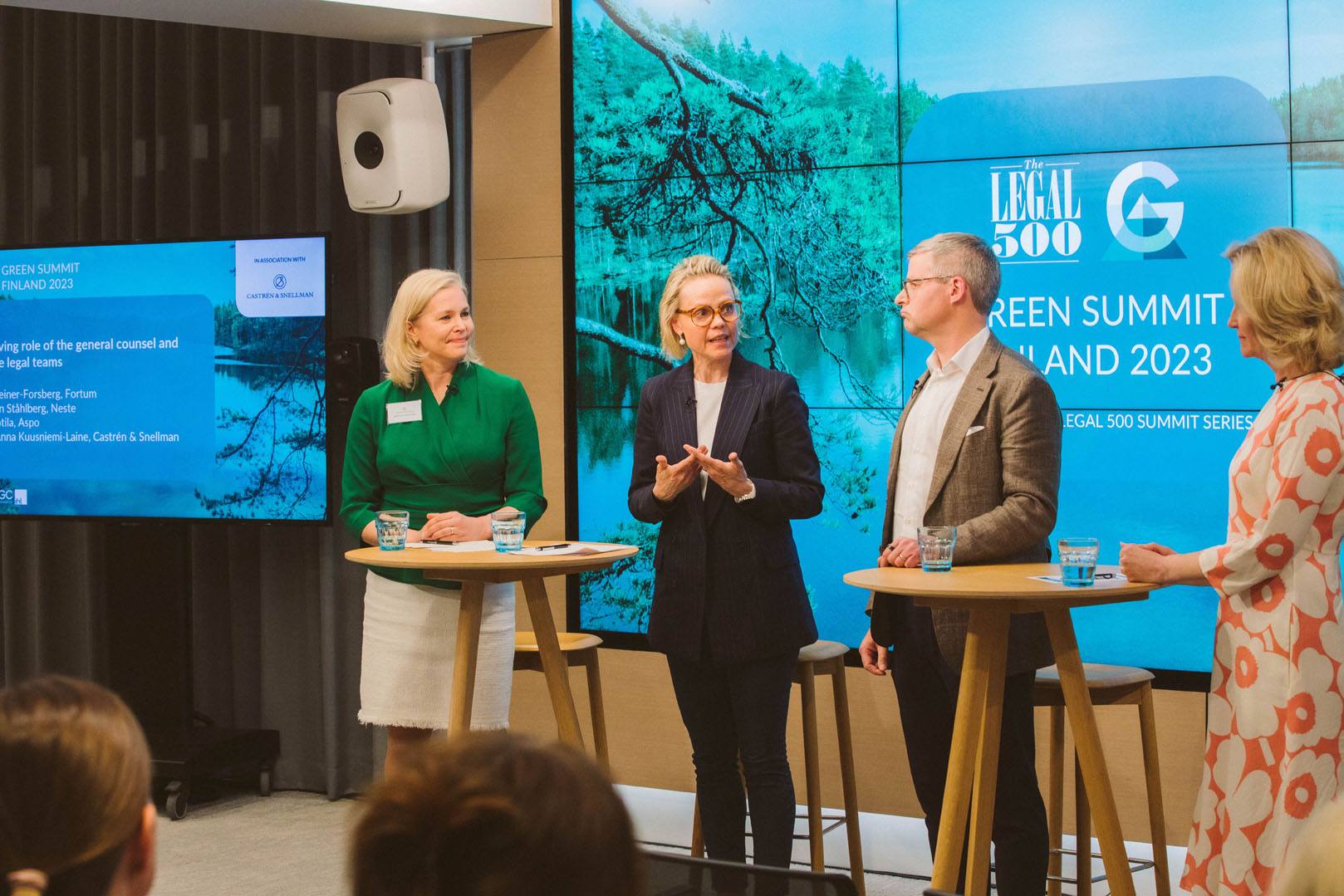Event Report
The Green Summit Finland 2023, hosted by Castrén & Snellman in Helsinki on 7 June 2023, marked the eight event in our Green Summit series associated with The Legal 500’s Global Green Guide, and the second time we held the summit in Finland. The event brought together leading practitioners and in-house counsel from across the country and region to discuss the legal sector’s contribution to a green transition.
Sakari Lukinmaa, managing partner at Castrén & Snellman, and Anna Bauböck, Global Green Guide editor at The Legal 500 kicked off the summit with a welcome address and some opening remarks.
Anna Kuusniemi-Laine, partner and head of sustainability at Castrén & Snellman, proceeded to chair the first panel which examined the evolving role of the general counsel and corporate legal teams. In this first discussion, the audience heard from speakers at frontrunner companies in the region: Nora Steiner-Forsberg, general counsel at Fortum; Christian Ståhlberg, general counsel at Neste; and Taru Uotila, general counsel at Aspo.
Kuusniemi-Laine set the scene before the discussion, pointing towards how today’s various crises from the pandemic to the war in Ukraine can in fact accelerate progress. Many companies in the region have strengthened their ESG commitments, yet ESG risks and opportunities are changing, and ESG issues are increasingly investigated or taken to court.
A key take-away of the first panel was that sustainable business is the only option, and a key theme was the powerful role inhouse counsel play when it comes to ESG and a green transition due to the influence legal teams can have in corporate decision-making. As Uotila put it: The legal department is there to achieve company goals, and those goals need to involve sustainability if the company wants to survive – therefore ESG is inevitably an integral part of the legal teams’ job.
Lawyers’ role is to balance those ESG risks and opportunities. As Steiner-Forsberg pointed out, lawyers should turn the current ESG regulatory tsunami into a business case, finding the benefits rather than focusing on the burden it may present.
Ståhlberg proposed the adoption of a holistic view, looking at the big picture. He stressed that creating a sustainable business is the only long-term solution, that businesses also need to remain profitable, and that therefore companies need to be innovative. In his opinion, lawyers should think about influencing with a long-term vision.
Two other main points of the discussion around the evolution of the GC role included: firstly, lawyers cannot work in silos, need to talk to colleagues in different functions, and need to stay curious, open minded and up-to-speed; and secondly, legal interpretation forms only a small part of lawyers’ role – today it’s about so much more than mere technical implementation.
After a lively Q&A session followed by a short coffee break, the second panel, chaired by Minna Korhonen, partner at Castrén & Snellman, looked at current trends in sustainable finance and the financing of the net zero transition. The audience heard from speakers and experts Juho Maalahti, country lead sustainable finance advisory at Nordea Bank; Antti Malava, head of sustainability insights & analytics at Danske Bank; and Vilppu Tarvainen, head of DCM Finland & Baltics at SEB.
First, the discussion focused on the context of the Nordic market: The Nordics have been frontrunners in sustainable finance with regulation driving the market, as well as a fear of missing out mentality, especially on the capital markets side. Maalahti illustrated this by pointing to the fact that 60% of corporate bonds were issued under the ESG umbrella in the Nordics, compared to around 30% across Europe.
Malava highlighted that today investors want to associate investments with something good for the world. Referring to the interplay between supply and demand, Tarvainen commented that the demand for sustainable finance was there, and regulation has helped to give it more supply. He added that there has been such a shift in balance that there is now a chance of running out of green assets.
A central part of the discussion revolved around the hot topic of greenwashing. All speakers agreed that the market is currently trying to understand what constitutes greenwashing, there is still no common definition and a great need for regulators to establish this. In particular, this needs to involve the distinction between intentional and unintentional greenwashing
Maalahti stressed how terminology matters, and also drew attention to the fact that some regulation hasn’t worked out the way it was intended. Tarvainen additionally commented on the problem of inverse greenwashing: What is sustainable enough; what is credible in investors’ eyes? He gave the example of a very sustainable product in a very unsustainable company. Malava illustrated how ESG ratings are measuring different things because of a lack of clear definitions.
When Korhonen asked about the scope of comparative data, Malava questioned the possibility of making data comparable when it is being measured differently. Again, the speakers agreed on the need for increased standardisation. As Tarvainen summed it up: We currently have lots of pieces of a big puzzle, but we don’t yet know how they need to be put together.
After another engaging Q&A from the audience and some brief closing remarks from Kuusniemi-Laine, the evening was rounded off by a drinks reception giving participants and speakers a chance to mingle, network and continue the conversation.

